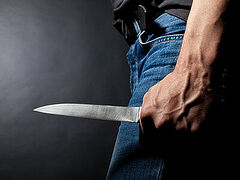Kalinovka, Vinnitsa Province, Ukraine, July 11, 2023
On July 6, the Ukrainian Orthodox Church celebrated the 100th anniversary of the Kalinovka Miracle, which occurred in 1923, when the Soviet authorities were desperately trying to disprove the reality or relics and all miracles.
The feast was celebrated at the Holy Cross Church in Kalinovka by His Eminence Metropolitan Sergei of Ternopil with His Eminence Metropolitan Agapit of Mogilev-Podolsky, the local hierarch, His Eminence Metropolitan Barsanuphius of Vinnitsa, and local and visiting clergy, reports the Vinnitsa Diocese.
The service was held at the miraculous cross from which blood flowed when it was shot by a Red Army soldier (see below for the full story).
At the Small Entrance, clerics of the Kalinovka Deanery were given various liturgical awards. Special prayers for peace were offered during the Liturgy.
After the service, Met. Barsanuphius addressed the clergy and faithful with a sermon about the miracle that had occurred on that site 100 years earlier.
***
Dimitry V. Pospielovsky writes about the miracle in his A History of Soviet Atheism in Theory, and Practice, and the Believer, Vol. 2: Soviet Anti-Religious Campaigns and Persecutions:
In the Soviet Union it was ideologically important for the government to suppress and disprove accounts of miracles that contradicted Marxist atheism. To this effect the government issued a decree on March 1, 1919 regarding 'the complete liquidation of the cult of corpses and mummies', which ordered the public exposure of saints' relics in order to show them to be frauds (to counter the belief that the saints' bodies were miraculously preserved). In 1918 there were even calls to outlaw the sacrament of the Eucharist on account of its miraculous transformation as believed by Orthodox and Catholic Christians.
One of the most famous of these miracles occurred in the village of Kalinovka near Vinnitsa in the Ukraine. On 7 July 1923 a detachment of mounted police had come to the village in order to close the local church, but they were met by hostile crowds. The idea was for the police to get the people to sign a “unanimous petition” to close the church, but all they met were women screaming: “Close the synagogues first, if you don't need them. We want to keep our churches …” Workers from the factories came to protest as well as many peasants, eventually leading the commissar to disperse his soldiers.
The crowds being too big for the police to force their way through, they eventually retreated. Not far from the church, however, there was a traditional wooden Crucifix standing at a crossroads, and the policemen in frustration fired at the crucifix on which hung an image of Christ crucified made of thick sheet metal and painted in oil. One of the bullets hit the crucifix in Christ's side and suddenly blood gushed out of the hole reportedly. One of the policemen lost control of himself and fell off his horse, while the others took off. The crowd went on its knees and prayed in front of the bleeding crucifix.
The news spread and thousands of people came to see it. By evening 30,000 people came to pray. The special commandos called “Tson troops” came along with them. What then happened can hardly be described in words. The horses belonging to the commandos bolted and galloped away despite the horsemen's attempt to stop them. A Jewish factory worker, his wife and their two children asked to be baptized into the Orthodox Church, and this was done before the assembled masses.
The blood reportedly kept gushing out for several days. Soon after more police came with orders to hack down the crucifix but each time they returned in failure under the claim that some force was preventing them from approaching it. The local communist press tried to explain the phenomena by claiming that there had been an accumulation of water in the wooden cross behind the metallic figure, and that once the bullet hit the metal, the water which had turned red from the metal's rust, must have seeped through. The crowds brought crosses with them that they set up beside it, prayed before it and dipped cloths in the miraculous blood. Four days and nights they sung hymns as well as burned candles. Priests were absent in fear. Many atheists reportedly converted after seeing this. A Jewish doctor took samples for a blood analysis,
At the very first opportunity the Soviets destroyed the bleeding Crucifix and all adjacent crosses. It was later claimed that a commission of experts had reported that the fluid coming out of the bullet hole was not blood. The newspaper Evestia wrote that “soldiers were shooting in fun, and without any particular target, when a stray bullet happened to hit a rusty ‘sheet-metal Christ’. Moisture ran out of the 'wound' together with rust.” The people who had gathered there that day were later depicted as drunkards, fools and scum, and it was claimed that the kissing of the Crucifix had resulted in an outbreak of syphilis as well as mass robberies.
The workers and peasants became courageous after this miracle and took out all their hidden icons. They hung them in their homes and defied the threats of the communists. Every year since then the people gather in the thousands (in 2008 11,000 people attended) on July 7th for a procession with the Holy Cross.
(Excerpt posted at Mystagogy)
Follow OrthoChristian on Twitter, Vkontakte, Telegram, WhatsApp, MeWe, and Gab!







